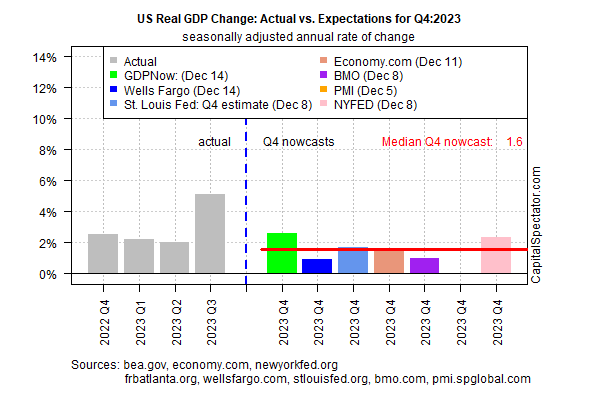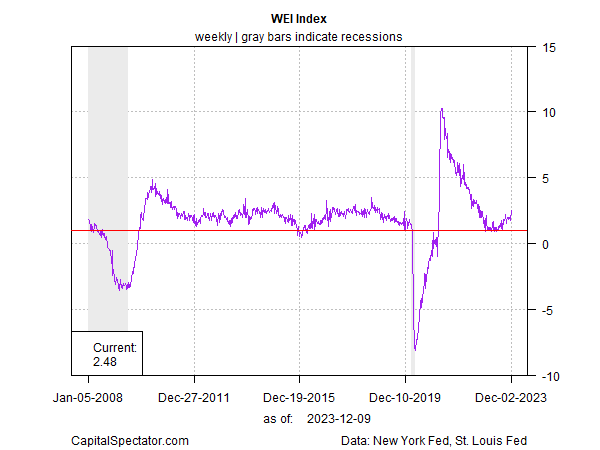US economic activity is still on track to slow after strong growth in the third quarter, but recession risk remains low, based on a set of nowcasts compiled by CapitalSpectator.com.
Next month’s official Q4 GDP release from the Bureau of Economic Analysis is expected to report the economy expanded by 1.6% (seasonally adjusted annual rate), based on the median for a set of estimates.
Today’s revised nowcast marks a sharp deceleration from Q3’s strong 5.2% increase.

Note, however, that today’s Q4 nowcast also reflects a firmer rate of expansion compared with the previous 1.2% for the current quarter, published on Dec. 8.
The so-called soft-landing outlook for the economy — softer growth that helps tame inflation but avoids recession — still looks plausible in today’s update.
“I have always felt, since the beginning, that there was a possibility, because of the unusual situation, that the economy could cool off in a way that enabled inflation to come down without the kind of large job losses that have often been associated with high inflation and tightening cycles,” Fed Chairman Jerome Powell said on Wednesday.
Market sentiment appears to agree, according to a new survey via The New York Times:
“Respondents in a survey of market participants carried out regularly by the research firm MacroPolicy Perspectives are more optimistic about the odds of a soft landing than ever before: 74 percent said that no recession was needed to lower inflation back to the Fed’s target in a Dec. 1-7 survey, up from a low of 41 percent in September 2022.”
Forecasters who still see elevated recession risk on the near-term horizon say that the economy will face stronger headwinds in 2024.
Maybe, but expectations that the Fed will cut interest rates next year – six times, according to Morningstar’s US economist – will provide support for growth, which will offset some of the slowdown threat.
Meanwhile, it’s increasingly clear that the US economy will exit 2023 with a clear growth bias. That may be the consensus view now, but just a few months ago there was widespread skepticism.
But as reported on these pages in September, for instance, the warnings from some corners that recession risk was high were less about clear-eyed analysis of the numbers vs. fuzzy forecasting notions.
Three months later the real-time numbers still suggest that recession risk is low. That’s not only reflected in the current median Q4 GDP nowcast; it’s also a view via a broad set of indicators monitored in the weekly updates of The US Business Cycle Risk Report.
In the Dec. 10 edition of the newsletter, for instance, the New York Fed’s Weekly Economic Index is highlighted. This multi-factor index rose to its highest level in over a year through Dec. 7 – a level that strongly suggests recession risk is low.
The red line indicates the estimated level that signals recession.
The recessionistas keep moving up their estimates for when economic contraction will start. Meanwhile, the incoming data continue to defy the dark forecasts.
At some point, the pessimists will be right, but for now, the proposition that the US economy is on the precipice of recession still looks like a low-probability event.
